If you’re thinking about making money online, you’ve probably come across Michelle Schroeder-Gardner and her course, Making Sense of Affiliate Marketing. But with so many scams out there, it’s natural to wonder if this one is the real deal.
I’ve done my homework and thoroughly researched Making Sense of Affiliate Marketing, so you don’t have to. And as a disclaimer, I want you to know that I’m not affiliated with Michelle Schroeder-Gardner in any way. That means you can trust my review to be honest and unbiased.
In this review, I’ll share with you everything you need to know about Making Sense of Affiliate Marketing – what it is, how it works, and whether or not it’s worth your time and money. And if you decide it’s not the right fit for you, I’ll even recommend an alternative that has helped me earn a full-time passive income online.
So let’s dive into Making Sense of Affiliate Marketing!
Making Sense of Affiliate Marketing Review – Key Takeaways
- Course Name: Making Sense of Affiliate Marketing
- Course Instructors: Michelle Schroeder-Gardner
- Price: $197, or two payments of $99
- Pros: The community is active and supportive
- Cons: Short and generic training. Lack of over-the-shoulder examples.
- Overall Rating: 2/5
- The Best Alternative: An All-in-One Platform to Make Passive Income Online
Table of Contents
- What is Making Sense of Affiliate Marketing?
- Who is Michelle Schroeder-Gardner?
- What’s Inside Making Sense of Affiliate Marketing?
- Who Is This Course For?
- Are Students of This Course Getting Results?
- How Much Does Making Sense of Affiliate Marketing Cost?
- Refund Policy
- Praise For Making Sense Of Affiliate Marketing
- Criticisms For Making Sense of Affiliate Marketing
- Is Making Sense of Affiliate Marketing a Scam?
- Final Verdict
- Making Sense of Affiliate Marketing Alternative
What is Making Sense of Affiliate Marketing?
Michelle Schroeder-Gardner’s Making Sense of Affiliate Marketing course is a step-by-step guide promises to help you create and make money from your own affiliate marketing strategy.
Michelle claims to reveal all the ins and outs of affiliate marketing, so you won’t be left wondering what to do next. However, some potential customers might be skeptical because the course doesn’t provide any specific strategies in advance. Michelle cannot give everything away before you purchase the course, but it would be helpful if she shared what types of strategies are covered in the course.
Despite this, Making Sense of Affiliate Marketing is a popular course. In February 2019, Michelle earned an average of $37,000 per month with six people signing up for the course every day. With numbers like these, it’s no wonder why so many bloggers are eager to learn more about affiliate marketing from Michelle.
Recommendation: Here’s The Best Alternative
Who is Michelle Schroeder-Gardner?
Michelle Schroeder-Gardner is a personal finance blogger, and you can find her at MakingSenseofCents.com. Her blog has been up and running since 2014, and it has become quite successful. In fact, it’s so successful that she is now able to travel full-time in her RV!
Michelle’s blog is all about personal finance, and she shares helpful tips and tricks to help you save money, pay off debt, and achieve financial freedom. But what’s even more impressive is how much money she makes from her blog!
In March of 2018, Michelle made a whopping $241,659 from her blog alone! A significant portion of that came from affiliate marketing, which accounted for $187,785. Michelle is clearly an expert in this area, and she has even created a course called Making Sense of Affiliate Marketing to help others learn how to do it too.
According to Michelle, she has been earning $50,000 a month or more from affiliate marketing alone since 2016. That’s pretty amazing if you ask us!
However, it’s worth noting that Michelle reported a significant decline in her earnings after December 2018. Regardless, she remains a well-known figure in the personal finance and blogging worlds.

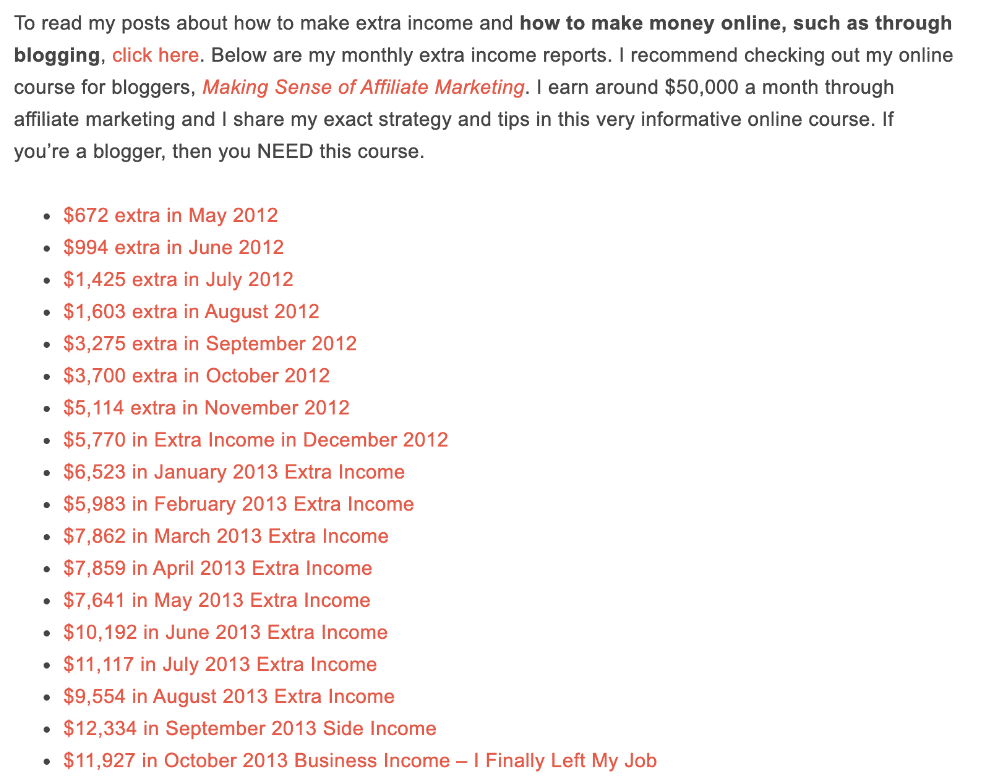
Recommendation: Here’s The Best Alternative
What’s Inside Making Sense of Affiliate Marketing?
Affiliate marketing can be a lucrative way to earn money through your blog or website, and “Making Sense of Affiliate Marketing” is a comprehensive course that can teach you everything you need to know to get started.
This course is written in an easy-to-follow format and includes workbooks, exercises, and strategies for creating a successful affiliate marketing plan.
The course is divided into six modules, each covering a different aspect of affiliate marketing. Here’s what you can expect from each module:
Module 1: What Is Affiliate Marketing?
This module provides an overview of affiliate marketing, including why and how companies have affiliate programs. You’ll learn the basics of how to get started with affiliate marketing.
Module 2: How To Find and Apply To Affiliate Programs
This module will teach you how to find affiliate programs and select the right products to promote. You’ll also learn how to apply to affiliate programs and get approved.
Module 3: Follow The Rules
The FTC requires affiliate posts to include a legal disclosure statement. This module will cover the disclosures you need to include to comply with FTC regulations.
Module 4: How To Get Your Readers To Convert
This section will teach you how to get your readers to click on your affiliate links and make purchases. You’ll learn how to create content that converts and build trust with your audience.
Module 5: Strategies and Ways To Promote Affiliate Links
In this module, you’ll learn the best ways to promote your affiliate products and increase your chances of earning commissions. You’ll also learn how to use social media, email marketing, and other tactics to promote your affiliate links.
Module 6: Rinse and Repeat
This module will teach you how to maintain an affiliate marketing strategy for long-term success. You’ll receive a checklist in this section for maintaining your affiliate strategies.
Bonus Materials
In addition to the modules, the course includes several workbooks, checklists, and bonus materials to help you succeed. Here are some of the bonus materials you’ll receive:
- How To Always Get Approved for Affiliate Programs
- How To Drive Thousands of Visitors To Your Blog with Pinterest (Video)
- 9 Things You Must Do When Something Goes Viral
- How To Increase Your Page Views
- Affiliate Products and Services (Worksheet)
- The Perfect Affiliate Link Checklist
- How To Maximize Your Reach, Your Impact, and Your Revenue with Facebook Ads
- Editing and Writing Strategies That Will Take Your Content To the Next Level
- How To Legally Protect Your Blog (Video)
Learn more:
Recommendation: Here’s The Best Alternative
Who Is This Course For?
As an avid supporter of affiliate marketing, I was thrilled to delve into the highly-acclaimed course, Making Sense of Affiliate Marketing. However, after extensive exploration, I can’t recommend it with a clear conscience. Allow me to explain why.
While the course offers some noteworthy teachings and ideas, they lack depth and are riddled with significant gaps. In fact, I discovered that 90% of the material covered can easily be found online for free.
Although Michelle has a successful blog, the course fails to provide practical guidance on essential aspects of affiliate marketing.
To be fair, “Making Sense of Affiliate Marketing” could be repackaged into a more suitable medium like a $10 eBook or a Udemy course. However, even in these formats, the training is inadequate and not worth the price.
To avoid wasting your time and money, consider exploring these better alternatives to hone your affiliate marketing skills.
Recommendation: Here’s The Best Alternative
Are Students of This Course Getting Results?
Despite the growing popularity of Making Sense of Affiliate Marketing, there seems to be a lack of success stories from its students. Although there are only eight testimonials on the course sales page, only a few of them reveal specific results achieved, while others offer general praise for Michelle, the creator of the course.
It’s worth noting that the first testimonial dates back to 2017, and the author credits her blogging success to a different course elsewhere. Even more telling are the comments in the weekly “Winning Wednesday” posts on the MSoAM Facebook group, where only a few students report significant income earned from affiliate marketing.
With about 250 new students joining the course every six weeks, one would expect to see more success stories posted online. However, there is a surprising lack of criticism of the course material and few requests for refunds.
Could it be that Michelle’s likeable personality prevents students from criticizing her course? Or maybe the massive success Michelle has achieved as an affiliate marketer leads students to assume they are at fault when her training doesn’t work for them, so they are less inclined to ask for a refund.



How Much Does Making Sense of Affiliate Marketing Cost?
With the course priced at $197, many people are wondering if there are any ways to get a discount or even access it for free.
As tempting as it may be to search for a free download, it’s important to remember that pirating courses is not only unethical, but it’s also illegal. Luckily, Michelle offers a 30-day money-back guarantee, so you can purchase the course and request a refund if it doesn’t meet your expectations.
If you’re looking for a discount or coupon code, you’re not alone. Unfortunately, there isn’t a regular or scheduled promotion available at this time. However, in the past, Michelle has offered up to 20% off the course for a limited time, so it’s worth keeping an eye out for future announcements. Be sure to sign up for Michelle’s mailing list to be the first to hear about any upcoming promotions.
It’s important to note that while the course itself may be a one-time payment, there may be additional costs that aren’t mentioned on the sales page. Michelle may recommend purchasing other products or services to enhance your affiliate marketing experience, so keep this in mind when budgeting for the course.

Learn more: How Much Does It Cost to Start Affiliate Marketing
Refund Policy
Making Sense of Affiliate Marketing offers a 30-day money-back guarantee that’s easy to obtain, as long as you can show that you’ve given the course a fair shot.
Now, we know what you’re thinking: “Conditional refunds? No, thank you!” But wait, before you click away, hear us out! We’ve heard from satisfied customers who’ve received full refunds without any trouble. In fact, one reviewer even received a refund after sending in a draft of their review along with the refund request!
So, how do you get that refund? Simply shoot an email to [email protected] and provide proof that you’ve completed the course and taken action on what you’ve learned.
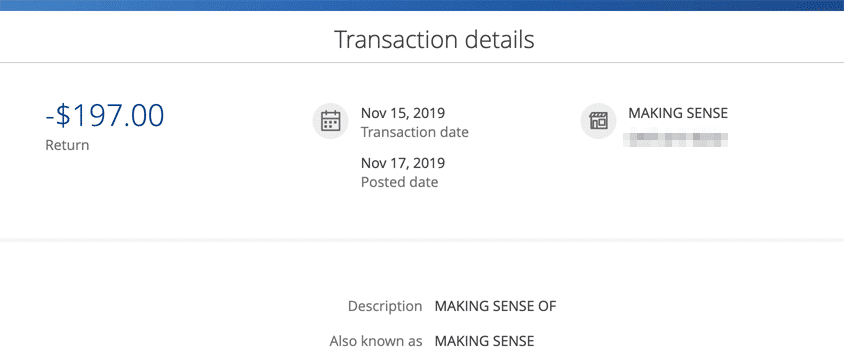

Recommendation: Here’s The Best Alternative
Praise For Making Sense Of Affiliate Marketing
Active + Supportive Community: Connecting with Newbie Affiliate Marketers
One of the best parts of Making Sense of Affiliate Marketing is the private Facebook group. Once you join the course, you’ll gain access to an active and supportive community of aspiring affiliate marketers. With quick responses and frequent posts from Michelle, you can get your questions answered in no time.
While the majority of members may be new to affiliate marketing, the group provides a great platform to connect with like-minded individuals. Michelle also takes time to interact with members, offering specific feedback and advice.
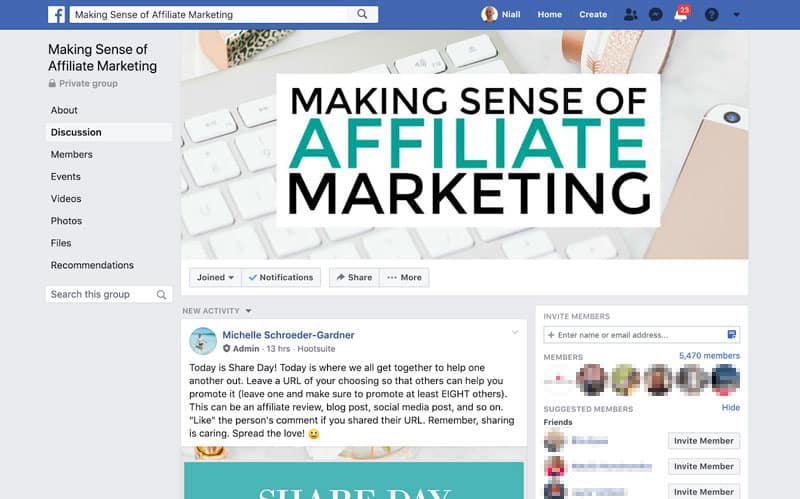
White Hat Throughout: Honest and Ethical Approach
In the world of affiliate marketing, it can be tempting to resort to shady marketing tactics. But Making Sense of Affiliate Marketing takes a different approach. Michelle emphasizes the importance of an honest and ethical approach to affiliate marketing. From requirements and disclosures to nofollowing links, the course covers all the basics.
This sets it apart from other courses, like Wealthy Affiliate and ClickBank University, that may promote questionable practices.



Lifetime Access, Free Updates: No Recurring Payments
When you invest in Making Sense of Affiliate Marketing, you’ll get lifetime access to all the course materials, the private community, and future updates. Plus, there are no recurring payments to worry about. While there haven’t been many updates to the course since 2016, the lack of recurring payments makes it a good deal.
Some Decent Lessons: Bonus Lessons Steal the Show
While the course may have its shortcomings, some of the lessons are worth your time. Especially if you’re new to affiliate marketing. The course offers two bonus lessons from guest trainers about Pinterest and Facebook Ads. These lessons stand out because they provide real, visual examples and engaging video formats.
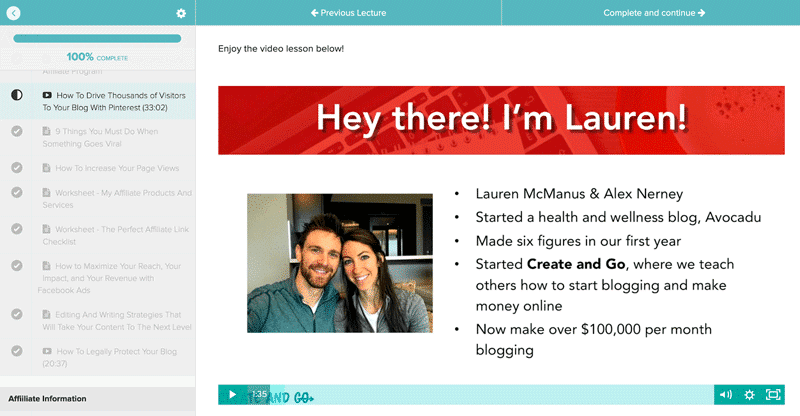
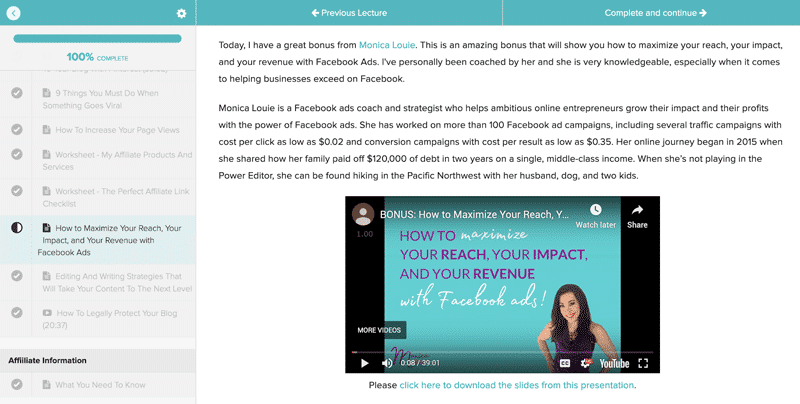
Recommendation: Here’s The Best Alternative
Criticisms For Making Sense of Affiliate Marketing
1. The Good Reviews are Written by Michelle’s Affiliates
You probably have found some other reviews of Making Sense of Affiliate Marketing and most of them are saying good words.
Those bloggers, however, actually receive a large commission if you purchase Making Sense of Affiliate Marketing using their links. Therefore, their words are often biased and not trustworthy.
The reviews are merely sales pages that do not inform you about the hidden costs or the difficulty of making money using Michelle’s strategies.
When you search Making Sense of Affiliate Marketing review, you might see a website called
The Savvy Couple ranking the first page on Google:

Be careful! They are the super affiliate of Making Sense of Affiliate Marketing, meaning they make thousands of affiliate commissions by promoting Making Sense of Affiliate Marketing.
The 9/10 rating is just a sales tactic. Should you trust someone who has a conflict of interest and receives huge compensation to “review” a course? No, probably not. It’s not a review, it’s a sale!
Therefore, I recommend reading the reviews of those written by the non-affiliates of Making Sense of Affiliate Marketing.
I tried to search for the real user reviews of Making Sense of Affiliate Marketing on Trustpilot, which is the most credible review site:

However, it’s weird to find no reviews at all on Trustpilot. This is unusual for a course that claims to have helped thousands of people succeed in affiliate marketing.
If it’s true, there should be many good ratings there.
2. The Training is Too Shallow and Generic
Despite making claims to be a “step-by-step affiliate marketing course,” the course lacks depth and specifics. Almost every topic the course covers can be found on the web for free.
It is perhaps best illustrated through Michelle’s lesson titled, “Teaching With Tutorials.” As a result, the lesson is only 612 words long, without any screenshots.
The lesson from Michelle about creating reviews isn’t much better, with 1182 words and four screenshots.
Making Sense of Affiliate Marketing delivers the same value in every lesson.
Yes, Michelle at least has all of the information organized for you in one place.
But I lost confidence in the training so much that I often had to turn to Google for more detailed and current information.
3. No Technical Support
You will probably require technical assistance sometimes if you are new to online marketing. Making Sense of Affiliate Marketing, however, only offers courses, not technical support.
Therefore, if you encounter technical problems with your website, you have no one to contact. Newbies in online marketing should be concerned about this.
After paying so much for the course, you will feel helpless when you expect to receive all kinds of support.
My #1 recommended platform is different. You will get 24/7 technical support with your website.
They have a technical team standing by any time to help you when you encounter technical problems. It’s really like having hired a technical team. Also, there is a community of a million members there to help you out when you have questions.
4. Lack of Practical Examples
You’ll find many claims and recommendations in Making Sense of Affiliate Marketing, but few citations or detailed instructions.
As an example, you are told to evaluate the management of each affiliate program you are interested in, but you are never shown how to do so.
Michelle said Interviews are an effective way to promote affiliate products but provide no data or examples to support her claim.
You’re constantly told to “grow your list” and “track your progress,” but you’re never provided with any walk-throughs or instructions on how to do that.
There is a note telling you that it’s important to “be an expert,” but that’s all the “instruction” you get on how to accomplish that.
Despite the fact that you are told that some strategies on social media don’t work, you are not shown any examples or screenshots of these strategies.
There is a “number to calculate” mentioned, but no instruction as to how you can find the data such a calculation requires.
A “help sheet” is recommended, but you’ve never shown what it should look like or what it should contain
Throughout the course, you will see many more examples of TELLING without SHOWING.
To learn affiliate marketing this way is like reading 100 pages of text plus 10 pictures to learn how to fly a plane.
5. No SEO Training
Its training on SEO is completely absent, unlike all other affiliate marketing courses I’ve seen.
However, according to statistics, Google is the top source of internet traffic in most industries, generating over half of it. Combined, Google drives 8 times as much traffic as all social networks.
Most top blogs receive 66.47 percent of their traffic from search engines, composed of 99.77% organic traffic and 0.23% paid traffic.
Therefore, in a course about affiliate marketing, you would expect to cover Search Engine Optimization (SEO).
However, I could only locate two mentions of SEO inside Making Sense of Affiliate Marketing:
Michelle admits she hasn’t relied on organic traffic to her website much, and this might be why this oversight has occurred:

Only in 2019 did she start learning SEO. Do you think you’re comfortable learning affiliate marketing from someone who’s new to SEO?
The majority of traffic to blogs comes from SEO. Yet Michelle’s appears to be getting most of its traffic from social media, particularly Pinterest.
The reason there are two lessons in Making Sense of Affiliate Marketing about Pinterest is explained by this.
Learn more:
6. Almost All Text, Very Little Video
Video is used a lot in online courses these days for teaching material. However, most of Making Sense of Affiliate Marketing’s lessons are text-based.
This is more or less how most of the lessons look: walls of boring text with only a few screenshots to break up the monotony.
While not every topic would be better served by video, several undoubtedly would, such as:
- Google Analytics – Can you do a screencast showing where each of the important metrics can be found in the Google Analytics interface?
- Content Creation – An in-depth look at Michelle’s process of creating content would be amazing.
- Social Media Marketing – What if Michelle showed how she selects and schedules her social media updates on a screencast?
- Email Marketing – Michelle mentioned the importance of email marketing. It would have been great to see a screencast showing how she prepares and sends out an email.
As it is, Making Sense of Affiliate Marketing has only three video lessons, and none of them is from Michelle.
7. Lack of Successful Stories of Students
While Making Sense of Affiliate Marketing claims that a lot of their students see results from the training, there is no verified evidence to show this.
You may see some reviews posting screenshots from their Facebook group as proof of the success stories. But there is no way to verify if those are true results or not.
Also, some students who joined Making Sense of Affiliate Marketing are not beginners, and they already have a well-established website before joining.
So their results might not be attributed to the training of Making Sense of Affiliate Marketing. That means even if some do get results, it’s unlikely that you can do the same if you are a complete newbie.
8. Making Sense of Affiliate Marketing Doesn’t Provide You With Any Tools
Making Sense of Affiliate Marketing doesn’t provide you with the tools for building an affiliate site.
For example, the keyword research tool is one of the most important tools in affiliate marketing. A keyword research tool like Ahrefs can cost at least $99/month.
The reason why they don’t include any tools in the course is that developing the tools is expensive.
Moreover, without providing you with any free tools, they can recommend relevant tools to you and earn affiliate commissions when you purchase those tools using their links.
By doing so, they can make more money from you.
My #1 recommended platform is different, you will get a free keyword research tool after you join. They create and develop the tools themselves, which are pretty advanced and easy to use. All are included in one single subscription fee. No upsells at all.
Also, My #1 recommended platform’s web hosting quality is comparable to some big names like WPEngine. The website speed is highly optimised when hosting on their servers.
9. Hidden Costs
The Making Sense of Affiliate Marketing sales page does not mention any additional costs.
Once inside, you’ll see a number of recommended paid products and services, such as:
- ConvertKit – $29 per month (ConvertKit has a lot of alternatives. Mailchimp, for example, offers a free plan allowing you to email 2000 subscribers. In her student’s opinion, Michelle seems to be in a grey area of promoting what is profitable first and then if it is helpful to the reader.)
- Tailwind – $9.99 per month
- Facebook ads – $100+ a month (Michelle suggests spending $10 to $20 to boost a Facebook post. However, it is hard to make them work for affiliate products anymore.)
- Website Legal Templates – $100+ (In a webinar lesson, which is really just a sales pitch, it is recommended you buy a package of “website legal templates” that will cost you more than $100 even with the discount code.)
10. The Training is Not Suitable For Beginners
Whether you’re a new blogger or an experienced one, Making Sense of Affiliate Marketing promises to be helpful. However, the course isn’t particularly useful for beginners.
There is very little information in the course on how to drive traffic to a new blog. There is nothing about how to create a blog from scratch.
In fact, the entire course appears to assume that you have already established a blog with decent traffic, but you don’t know how to monetize it.
That’s the situation Michelle was in at the beginning of 2014. She was blogging for 3+ years, and her site was receiving 100,000 visitors every month.
However, she had no idea what affiliate marketing was, and wasn’t even earning $1000 per month from it.
You might be able to learn some helpful tips from Michelle’s course if you are in a similar position.
However, it’s certainly NOT the best way to learn how to blog, whether you are a novice or a pro.
11. Low-quality PDF Learning Materials
There are lots of PDF “worksheets” and bonus “lessons” in Making Sense of Affiliate Marketing. In addition to the mediocre content of the PDFs (at best), the format will have you scratching your head.
There are some PDFs that ask you to handwrite entire paragraphs, for no apparent reason.
Why these “worksheets” are not offered as Google Docs or Google Sheets that students can easily copy upload and edit themselves is beyond me.
There are some “bonuses” within Making Sense of Affiliate Marketing that is also offered as PDF files for no apparent reason.
I’m wondering why those “lessons” aren’t just linked to the course material as normal web pages.
I would guess that adding such thin content to a PDF makes it appear more substantial.
12. Fake Bonus
Despite its many “great bonuses,” Making Sense of Affiliate Marketing misleads its customers in a number of ways.
As an example, when you are told that you will receive a PDF outlining what you should do to increase your page views, it turns out that the PDF only has 2 pages of basic information.
Recommendation: Here’s The Best Alternative
Is Making Sense of Affiliate Marketing a Scam?
This course is not a scam. You can definitely learn some useful stuff about blogging and affiliate marketing if you decide to invest in their course. Many bloggers recommend it, and some of them are affiliates who can earn commissions from promoting it.
However, the course has not been updated frequently since it was launched in July 2016, which could be a downside for those looking for up-to-date information. You might have to do some extra research to make sure the course material is still relevant.
Another issue is that Michelle, the creator of the course, doesn’t offer any data or argument to support her recommendation to promote affiliate products on Instagram. While Instagram is popular, it’s not necessarily the best platform for driving traffic to your website.
Additionally, Michelle seems to only recommend tools based on commission rates. Bluehost is an example of this, as it has earned her the most affiliate income over the years. However, some members of the MSoAM Facebook group have complained about Bluehost’s services, so it might be helpful if Michelle offered more options for her students to compare.
If you’re looking for an alternative, there’s no need to invest in Making Sense of Affiliate Marketing. There are other cheaper and better options out there that can help you succeed faster. In fact, I’ll share my #1 recommended platform in the last section.
Learn more: Make Money Online Scams: How to Avoid Them?
Recommendation: Here’s The Best Alternative
Final Verdict
If you’re looking for a comprehensive affiliate marketing course, Making Sense of Affiliate Marketing might not be your best bet. Although it does have some decent teaching and ideas, it falls short in terms of in-depth discussions and lacking content. In fact, for 90% of the topics covered, you can easily find better training online for free.
If you’re on a tight budget, you might want to consider getting Making Sense of Affiliate Marketing as a $10 ebook or Udemy course instead. While the training would still be fairly useless, at least it wouldn’t be excessively expensive.
The poor course materials and lack of success stories make it unlikely that many students are getting good results. However, Michelle, the creator of the course, is very likeable, so people are hesitant to criticize her course out of concern for backlash.
All in all, there are better options out there that provide more value for your money.
Recommendation: Here’s The Best Alternative
Making Sense of Affiliate Marketing Alternative
If you’re looking for an all-in-one platform to build your affiliate marketing business from scratch, look no further than Wealthy Affiliate. This platform provides everything you need to succeed, including web hosting, keyword research tools, community support, comprehensive training, and writing tools.
The best part? You can register for a free account and start your affiliate marketing journey right away, without paying a dime. If you love what you see, you can upgrade to the premium membership to unlock even more features. And unlike other platforms, Wealthy Affiliate doesn’t have any upsells.
But how much can you really earn with Wealthy Affiliate? One 21-year old student was able to make over $7,000 in just one week using the platform. And with over a million members and countless success stories, it’s clear that Wealthy Affiliate is a proven way to build a successful affiliate marketing business.
You can check out my full review of Wealthy Affiliate here.

Don’t just take our word for it – check out Trustpilot, where Wealthy Affiliate has an impressive 4.8 out of 5 rating with over 400 reviews. And with a simple pricing scheme (just $49/month or $395/year for the premium membership), there’s no reason not to give it a try.
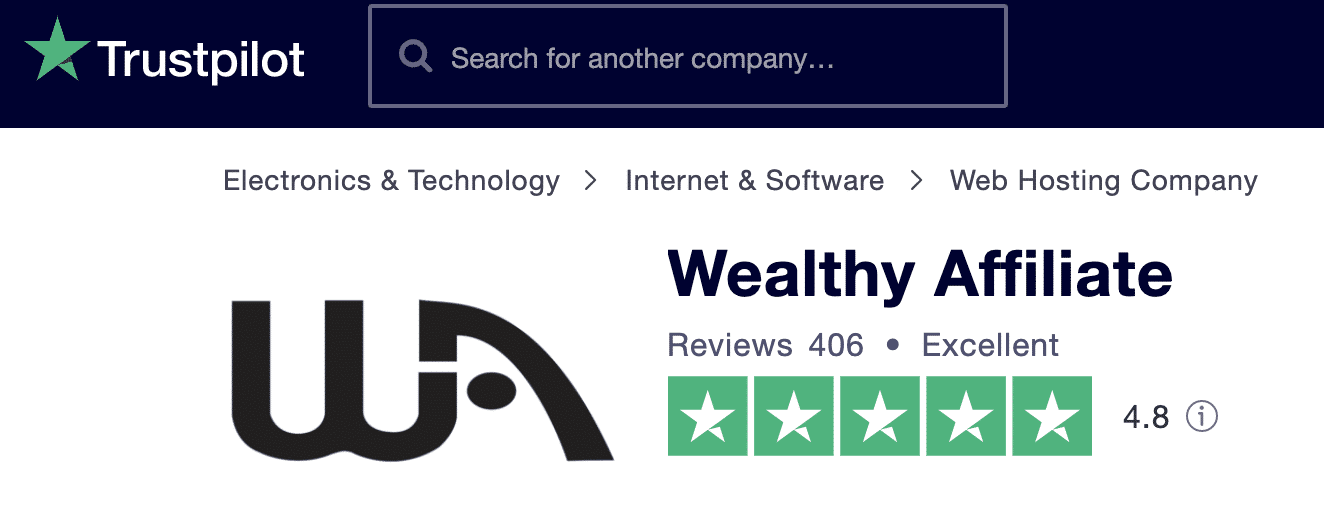
So what are you waiting for? Sign up for a free account today and see the Wealthy Affiliate difference for yourself.
Recommendation: Here’s The Best Alternative

Jeff Smith, Founder of High Income Source, is an online business coach with a BBA in Marketing and Entrepreneurship from the University of Pennsylvania. His online business coaching program is so popular that more than 100 students have benefited and started successful online businesses under his guidance.
Jeff started dabbling in online business while he was in college, where he began with dropshipping. After college, Jeff worked at a marketing agency and freelanced as a writer. His breakthrough came when he realized the potential of blogging, leading to a $100,000 sale of a dog-focused website. His expertise includes SEO, affiliate marketing, Amazon FBA, blogging and dropshipping.